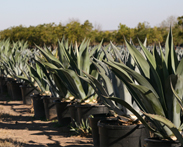
plants |
Winter Garden Agave (Agave Americana)
Agave americana was introduced into Europe about the middle of the 16th century and is now widely cultivated for its handsome appearance; in the variegated forms the leaf has a white or yellow marginal or central stripe from base to apex. As the leaves unfold from the center of the rosette the impression of the marginal spines is very conspicuous on the still erect younger leaves. The tequ plants are usually grown in tubs and put out in the summer months, but in the winter require protection from frost. They mature very slowly and are easily propagated by the offsets from the base of the stem called suckers or adventitious shoots. It has a spreading rosette (about 4 m wide) of gray-green leaves up to 2 meters (6 ft.) long, each with a spiny margin and a heavy spike at the tip. Its common name derives from its habit of only occasionally flowering, but when it does, the spike with a cyme of big yellow flowers, may reach up to 8 meters (25 ft.) in height. The plant dies after flowering, and the average life-span is around 25 years. Cultivated varieties include the 'Marginata' with yellow stripes along the margins of each leaf, 'Medio-picta' with a central white band, 'Striata' with multiple yellow to white stripes along the leaves, and 'Variegata' with white edges on the leaves. It is also known as the American aloe, although it is in a different family from the true aloes. If the flower stem is cut without flowering, a sweet liquid called agua miel ("honey water") gathers in the heart of the plant. This may be fermented to produce the drink called pulque, which may then be distilled to produce mezcal. The leaves also yield fibers, known as pita, which are suitable for making rope, matting, coarse cloth and are used for embroidery of leather in a technique known as piteado. Both pulque and maguey fibre were important to the economy of pre-Columbian Mexico. Production continues today to a much lesser extent. Agave syrup (also called agave nectar) has recently been marketed as a healthful natural sugar substitute. |
 One of the most familiar species of Agave is the
One of the most familiar species of Agave is the